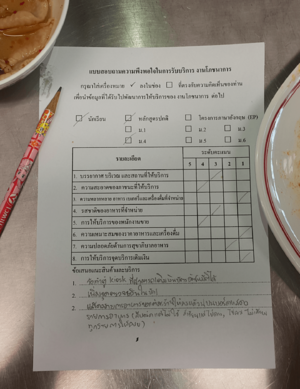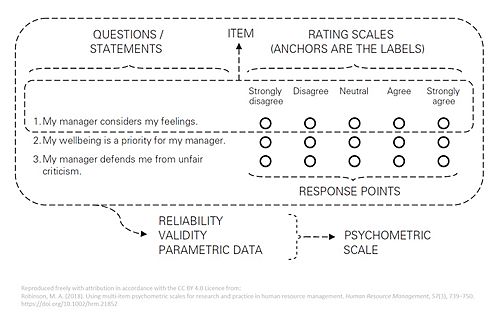Questionnaire facts for kids

A questionnaire is a special tool used in research to gather information. It's like a list of questions or prompts that people answer. Researchers use questionnaires to learn things from many people, often for a survey or study.
Most research questionnaires have a mix of two types of questions:
- Closed-ended questions: These give you specific choices to pick from, like "yes" or "no."
- Open-ended questions: These let you write your own answer and explain your thoughts.
The first research questionnaire was created in 1838 by the Statistical Society of London.
Questionnaires are helpful because they can be cheaper than talking to everyone individually. They also don't need as much effort from the person asking the questions. Plus, if the answers are standardized (meaning everyone picks from the same options), it's easier to collect and compare the data.
However, sometimes the choices in a questionnaire might not exactly fit what someone wants to say. Also, people need to be able to read and understand the questions to answer them. This means questionnaires might not work for everyone.
Contents
History of Questionnaires
One of the very first questionnaires was called Dean Milles' Questionnaire. It was used way back in 1753.
Types of Questionnaires
Questionnaires can be designed in different ways. Some questions measure separate things, while others are grouped together to measure a bigger idea.
Measuring Separate Things
Some questionnaires ask questions that measure individual pieces of information. For example, they might ask about:
- Preferences: Like which political party someone likes.
- Behaviors: Such as what foods someone eats.
- Facts: For instance, a person's gender.
Measuring Bigger Ideas
Other questionnaires have questions that are combined to measure a larger concept or idea. These might measure:
- Hidden traits: Things about a person that aren't obvious.
- Attitudes: Such as how someone feels about immigration.
- An index: Like a score for Social Economic Status.
Food Questionnaires
A food frequency questionnaire (FFQ) is a special type of questionnaire. It helps researchers understand what kind of diet people eat. For example, it can be used to check how much of certain vitamins or even harmful substances people consume.
How to Build a Questionnaire
Building a good questionnaire involves thinking about the questions and their order.
Types of Questions to Ask
A questionnaire usually has many questions that people answer in a specific way. Questions are either open-ended or closed-ended.
- Open-ended questions: The person answering writes their own response. For example, "What do you like most about school?"
- Closed-ended questions: The person chooses an answer from a list of options. The options should cover all possibilities and not overlap.
There are four main types of choices for closed-ended questions:
- Yes/No Questions: These give two options, like "yes" or "no." They are simple and often used to confirm information.
- Multiple Choice (Unordered): More than two options, but they don't have a specific order. For example, "What is your favorite color? (Red, Blue, Green, Yellow)."
- Multiple Choice (Ordered): More than two options that have a clear order. For example, "How often do you read? (Never, Rarely, Sometimes, Often, Always)."
- Sliding Scale: The person chooses a point on a continuous line or scale.
Sometimes, an open-ended answer is later turned into a specific choice. For example, if someone completes a sentence, their answer might be categorized.
Order of Questions
Questions in a questionnaire should flow logically. To get the best results, questions should generally go from:
- Less personal to more personal.
- Facts and behaviors to attitudes.
- General topics to more specific ones.
Here's a common order for questions:
- Screens: These are first to check if someone should even take the survey. For example, "Are you over 18?"
- Warm-ups: Easy questions to get people interested. They might not even be about the main topic.
- Transitions: Questions that help move smoothly between different topics.
- Skips: Questions that tell you to jump to a different section based on your answer. For example, "If yes, go to question 3. If no, go to question 5."
- Difficult Questions: These are placed near the end. By then, people are usually committed to finishing the survey.
- Classification Questions: These are about personal details, like age or gender. They are put at the end because they can feel private and might make people uncomfortable if asked too early.
Rules for Good Questions
Here are some basic rules for writing good questions:
- Make sure everyone understands the question in the same way.
- Write questions so that people with different opinions will give different answers.
- Consider adding an "other" option if you list possible answers.
- Focus on only one idea per question.
- Use positive statements and avoid confusing negatives.
- Don't assume things about the person answering.
- Use clear, simple words that everyone can understand.
- Always use correct spelling, grammar, and punctuation.
- Avoid asking two questions in one (e.g., "Do you like strawberries and potatoes?").
- Questions should not be biased or try to lead someone to a certain answer.
- You can use special research questions, like MaxDiff or Conjoint, to get useful data.
Using Many Questions for One Idea
In social science research, questionnaires often use several questions to measure one big idea. This is called a multi-item scale. Here's how it works:
- You ask multiple questions (usually 3 to 5 or more) about the same topic.
- Each question has a set of choices, often 5 to 7 options that are equally spaced.
- Each choice has a label, like "strongly agree" or "strongly disagree."
- These labels should be balanced to show equal steps between choices.
- A common type of scale is a Likert scale.
- When many questions measure the same idea in a reliable and accurate way, they form a multi-item scale.
- Researchers check if these scales are reliable (give consistent results) and valid (measure what they are supposed to measure).
- Special statistical tools, like Factor analysis, help develop these scales.
- Questionnaires often combine several of these multi-item scales.
How Questionnaires are Given
Questionnaires can be given in several ways:
- Face-to-face: An interviewer asks the questions out loud.
- Paper and Pencil: The questions are printed on paper for people to fill out.
- Computerized: The questions appear on a computer screen.
- Adaptive Computerized: The computer chooses the next questions based on how you answered the previous ones. This helps tailor the survey to you.
Things to Watch Out For with Questionnaires
While questionnaires are cheap, fast, and easy to analyze, they can have some downsides:
- Unlike interviews, researchers might not know if the person truly understood the question.
- Because questions are specific, the information gathered might be limited.
- Sometimes, questionnaires don't offer enough choices, forcing people to pick an answer that doesn't quite fit.
- Many people don't send back questionnaires, especially mail or online ones.
- Often, the people who *do* respond have very strong opinions (either very positive or very negative) and want to be heard. People with neutral opinions might not bother to respond.
Another concern is that questionnaires can have errors in measurement. These errors can be random (accidental mistakes) or systematic (a consistent problem with how the question or scale is designed). So, how a question is worded and its answer choices are very important.
Also, if the people chosen for the survey aren't a good representation of the whole population, the results might not be accurate. Getting a good sample of people is key to getting useful results from questionnaires.
See also
 In Spanish: Cuestionario para niños
In Spanish: Cuestionario para niños
- Behavioral Risk Factor Surveillance System
- Computer-assisted personal interviewing
- Enterprise Feedback Management
- Quantitative marketing research
- Questionnaire construction
- Statistical survey
- Structured interviewing
- Web-based experiments
- Position analysis questionnaire
- Abnormal construction


